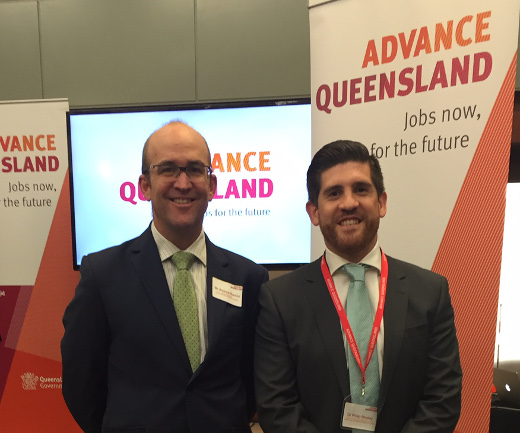 Andrew Barron on left and Dr Phil Mosley on right
Andrew Barron on left and Dr Phil Mosley on rightSt Andrew's War Memorial Hospital's Dr Philip Mosley received a $180,000 Advance Queensland Research Fellowship for his work on overcoming the negative impact of Deep Brain Stimulation (DBS) treatment on some people with Parkinson’s disease.
His funding was matched by the QIMR Berghofer Medical Research Institute, St Andrew’s War Memorial Hospital and Medtronic to give a total grant value of over $500,000.
DBS is a surgical procedure used to treat the movement symptoms of Parkinson’s disease. It involves implanting an electrode in the brain which is then programmed to deliver electrical stimulation.
“DBS is a wonderful treatment for most sufferers, but unfortunately a proportion of patients develop significant post-operative psychiatric symptoms,” Dr Mosley said.
“There is a cluster of psychiatric symptoms, characterised by impulsivity, disinhibition, recklessness and loss of empathy for others that develops in the early months after DBS and appears directly tied to the stimulation. We believe this to be the case because manipulating the stimulation field can immediately address these problems. However, our experience is that patients themselves may be unaware of their personality change and damage to relationships, reputation and finances often occurs before they can access appropriate treatment.”
Dr Mosley works as a neuropsychiatrist in St Andrew’s War Memorial Hospital's DBS program, which inserts about 120 devices per year and is one of the largest DBS centres worldwide. He said that the motivation for his research was driven by the trauma and suffering this cohort of patients and their families went through.
“My research aims to find a reliable method of predicting which patients are at risk before they undergo the DBS procedure. Furthermore, once the DBS electrodes are implanted, my research will assist the neurologist with programming the device so as to activate stimulation settings that are most likely to lead to motor improvement and least likely to lead to psychiatric symptoms,” Dr Mosley said.
He said his investigation comprised a series of neuropsychological tests and the use of state of the art brain imaging technology at the newly constructed Herston Imaging Research Facility.
He will examine the brain anatomy of patients with Parkinson’s disease to determine the best site for electrical stimulation and brain circuits that are associated with postoperative psychiatric symptoms.
“Using the cutting edge neuroscience tools available to us in Brisbane, we’ll produce a map of connections within the brain that are associated with psychiatrically safe stimulation. This knowledge will help to guide DBS electrode programming and improve the safety profile of this important therapy, which has been used to treat over 100,000 patients worldwide,” Dr Mosley said.
Dr Mosley is also from the QIMR Berghofer Medical Research Institute and the Asia-Pacific Centre for Neuromodulation.